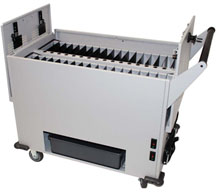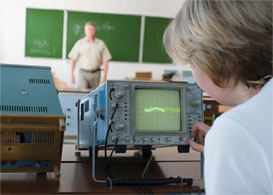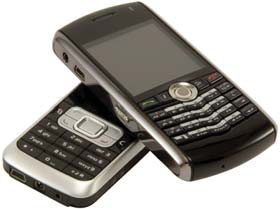News and Trends(33)

nextbigthing
Once you’ve locked in those stimulus millions to outfit every student with a Netbook
(any day now right?), don’t forget the essential accessories. Datamation Systems is one of the first to market (along with Bretford, see p. 38) with this sturdy device to secure, recharge, and transport mini PCs. The “Gather ’Round” design enables students to access both front and back sides. It holds up to 32 devices and provides outlets for charging batteries and other peripherals. The cart has been sized to be compatible with all major manufacturers.
Beyond the XO Laptop: Walter Bender on OLPC and Sugar on a Stick
Many people wouldn’t touch coffee or cereal without sugar. And the XO laptop would be useless without Sugar—the standard, Linux-based graphical interface for the little green laptops, nearly a million of which have been distributed to classrooms in developing countries and the United States by the Cambridge, MA–based One Laptop Per Child Foundation.
Despite the acrimonious divorce last year between OLPC founder Nicholas Negroponte (see Part I in T&L’s March issue) and the foundation’s former president of software, Sugar creator Walter Bender, the hardware and the software remain intertwined. In fact, not only are Sugar and all the programs that come with it (”activities” in Sugar lingo) still the keys to the XO laptop’s educational value, but they’re spreading beyond the XO to other platforms—and may well end up overshadowing the little laptop when it comes time to write the history of technology and education in the developing world. Wade Roush, chief correspondent for the business and technology Web site Xconomy.com, interviewed Bender on what’s next.
What’s the word with Sugar?
Walter Bender: [holding up a USB thumb drive] This is where we are. Live USB is going to be a really big part of Sugar in the next year or two, because it’s an easy way in the door. Most schools’ IT departments don’t even let teachers install software. The overhead associated with large IT infrastructures forces these people to be very conservative about adopting new ideas. So having Sugar on a Stick means we can hand this to a teacher or a student and they don’t have to have any impact on the existing infrastructure at all. They can be off to the races using Sugar and all its advantages in a computer lab, in a classroom, at the library, at home, on their parents’ computer, at an Internet cafe—wherever they can get a computer that they can boot off a USB, which is most computers these days. Everything is stored on the USB, so essentially your schoolwork walks around with you, in the form of your journal. We think it’s going to make Sugar a lot more accessible.
Tools and ideas to transform education. Sign up below.
It sounds like Sugar on a Stick lets you pretend you’re using an XO laptop without actually having one.
WB: You get all the advantages of the XO software environment, but you don’t need to be tied to any particular hardware. You don’t even need a laptop; you could do it with a desktop. So that’s a big thrust, in terms of our strategy for outreach and getting Sugar into the hands of more kids.
Nicholas Negroponte and others at OLPC have talked about a dual-screen, touch-based, keyboardless device as the model for the second-generation XO. Would Sugar work on the “XO 2.0,” or would it have to be significantly rewritten?
WB: I don’t really know anything about it. I know nothing about what the user-interaction paradigm is going to be. I do know that a lot of the netbook manufacturers are working on touch screens, and making Sugar take advantage of touch screens is something we’ll be working on.
But to me, the thing you want in elementary education is a tool that makes writing easy. So I am hoping that the idea of a keyboard isn’t totally abandoned. I think keyboards are the most efficient tools we have for entering text. On-screen keyboards and pen-based interfaces are nice romantic notions, but they are not very pragmatic.
Now, there is something about using paper and pencil, rather than a computer, that is undoubtedly important, in terms of motor-skill development. It’s important to interact with the physical world and manipulate things. But I don’t see it as an either-or proposition; you can have kids be doing lots of things with the physical world and also be using a computer. The big danger is not whether they are using computers instead of paper and pencil, but whether they are using iPods instead of paper and pencil. With these little touch-screen devices, rather than being expressive and making things, are they just consuming information?
That leads to a more general question. If constructionism is about learning through doing, don’t you really want kids out in the real world, doing arts and crafts and exploring the woods and collecting specimens? Obviously you can make and explore things on a computer, but in the end it’s just a flat, 2-D screen. So how big of a role should computers really play in education?
WB: I think that more arts and crafts, more getting out into the woods and collecting specimens: we need all of that. But one of the reasons why OLPC built a laptop is because a laptop can go out into the woods with you. You can take photos of the specimens, and plug in sensors and measure things. While Sugar will run anywhere, a laptop will always be the preferred environment, because a laptop is in vivo. It’s part of life.
It all boils down to this: the only time in school where we do open-ended problem solving—which is the kind of problem solving we encounter in life and on the job most of the time—is in art class. We value the things we measure, and what we measure through standardized testing is closed-form problem solving. So the thing that gets left behind, the thing we do less and less of in school—not because of computers, but because of the methods of measuring—tends to be the arts, construction, expression. So I don’t see it as being a question of the computer versus the physical world. I see that question as being, what are we valuing and measuring as a society in education?
What we’re trying to do with Sugar is not replace interaction with the physical world by any means. What we’re trying to do is say that whenever you are doing something with a computer, put the opportunity in play so that the learner can actually be expressive and make things. And further, one thing that happens in art class and doesn’t happen elsewhere is that you have this process called a critique. The culture of critique is actually missing from most other disciplines, but one place you do find it is in the open-source-software community.
Nicholas has often accused me of being an open-source fundamentalist, and indeed, there are two areas where I do think open source is fundamental. One of them is voting machines [meaning the code running inside these machines—long the subject of debate in election-policy circles]. And the other is education. People should be free to appropriate ideas and express them and free to critique them. That is so fundamental in education, and it’s also fundamental to the culture of open source, so it’s a really powerful synergy. What open source has to offer education is not just sharing software, but also sharing this culture of critique. As we fire all the art teachers in elementary schools, we are losing that. Hopefully, Sugar will be a way to retain it.
Meet AFT president Randi Weingarten
Former high school history teacher, lawyer, and union counsel, Randi Weingarten, president of The American Federation of Teachers (AFT), was elected to her influential post last July. She has also served ten years as president of the 200,000-member United Federation of Teachers (UFT), the largest union local in the U.S.

Weingarten, who describes herself as a child advocate and a proud trade unionist, on a mission “to help all our students succeed,” has become a respected public voice at a time that she characterizes as “a turning point in the American journey,” a pivotal moment in American education. Recently on the short list of senatorial candidates for the state of New York, she reflects on questions posed to her by T&L. What does the future look like at the AFT?
T&L: President Obama speaks of modernizing schools – how do you define that?
RW: President Obama sees a sound public education system as a cornerstone of a sound economy; improving the two are inextricably linked. AFT just launched a campaign called, “Fight for America’s Future: It’s Dollars and Sense,” to make sure funding at federal, state, and local levels continues to provide for Medicaid assistance for states, infrastructure that includes modernizing schools, funding for NCLB and IDEA, and money to ensure that higher education is not only accessible, but attainable.
T&L: What teaching strategies do you feel best embrace new technologies?
RW: Teachers, especially new teachers, spend considerable time and energy searching for or creating lesson plans, curricula, primary source documents, and other resource materials. They often turn to the Internet, where there is an abundance of information—sometimes too much—but no quality control. Teachers need the best resources that align with the high standards and curriculum they need to perform their jobs. Then they can use their time to hone their skills, adapt lessons to meet the needs of particular students, and assist and collaborate with colleagues.
T&L: What is your plan related to partnering with IT companies and others to develop online research networks with data on curriculum, lesson plans, and primary and secondary source documents, print and electronic?
RW: An online teacher resource network would help bring teachers into the 21st Century by facilitating their use of the Internet to support classroom instruction in practical and meaningful ways. At the AFT, we have committed to helping teachers grow professionally through technology. In New York, AFT members have partnered with public television to create a 24/7 TV channel and broadband service devoted to professional development of the K-12 workforce. We also launched a Website for educators to provide information, materials, and a set of lesson plans entitled “2008 Historic Election: A Teachable Moment,” to help students absorb moments of the history-making presidential campaign and election.
In addition, we’re a proud primary funder of Colorin Colorado, a free Website with information, activities, and advice for educators of English language learners (ELLs), and a variety of teaching and learning resources in Spanish geared towards their parents.
We have also collaborated with Teachscape, an online professional development company to create and offer online courses and resources for novice and veteran teachers.
--Barbara Axelson
The Mountain State Gets Modern
Higher ed helps high schools prepare for 21st-century learning
Thanks to a Congressional award and a three-year-grant from NASA to stimulate STEM-related interest, West Virginia’s smallest state campus, Glenville State College, is making a big difference with the state’s high-school science students. The school offers realtime experience of a college-level lab along with other distance education services provided by Polycom, NASA’s Digital Learning Network (DLN), and the Carnegie Museum of Natural History via video-conferencing technologies. “Most high schools don’t have major research instrumentation,” says Dr. Kevin
West Virgina is linking high school kids to college science labs. Evans, associate professor of chemistry/NASA program facilitator at Glenville State College. “We can take them into our research lab and discuss how to use the instrumentation.”

Document camera, which are used throughout classes and workshops. The latest device to be deployed is called the SPARK (see T&L’s Next Big Thing, April 2008). The small mobile data collector combines probe hardware with inquiry-based software programs. The color display screen allows finger-touch navigation for a probe, plug, and play experience.
“You can plug in probes to explore motion or force in physics, EKG and osmosis in biology, Beer’s law, and Ph in chemistry,” says Evans, “You can very quickly collect lab data and efficiently analyze that data by using the touch screen to create a graph or table.”
Participants in the program also get hands-on experience with research instrumentation typically reserved for graduate school students, such as spectrometers and even a DNA sequencer. Weekend field trips are spent collecting ride data to analyze amusement-park physics with the Pasco Xplorer or getting behind-the-scenes access to labs in top museums like the Smithsonian or Green Bank National Radio Astronomy Observatory. “It’s clearly a way to see what’s out there in the state, who’s really talented, who’s really enjoying it and energetic,” says Evans.
—Sascha Zuger
Five Ways To Use Phones In Class
1. LITERATURE: Manybooks.net (FREE) boasts more than 23,000 book titles. New aspiring “Kindle killers,” like Shortcovers (www.shortcovers.com; $10 to $20 per book), offer free apps for iPhone, Blackberry, and Google phones.
2 ART: Students can paint their adventure in a creative digital light using text messaging, voice recorders, and camera and movie phones.
3. SCIENCE & MATH: Thanks to
their camera, internal GPS, and accelerometer, the iPhone and iPod Touch are poised to replace the dozens of science kits cluttering your storeroom.

4. SOCIAL STUDIES: Social-media platforms like Twitter bring the global perspective into your classroom, enliven current-events class, and show historic debates still raging online. TinyTwitter (FREE) works on any Java-enabled cell phone.
5. FOREIGN LANGUAGES: The Langtolang Dictionary app (FREE) offers Google Android users access to more than 2,000 bilingual dictionaries. Quickdictionary ($18) can be downloaded on a variety of cell-phone formats.
—Ron S. Doyle
How to sell in-class gaming
Drawn from the recent report Guidelines for K–12 Education released by the SIIA. For the full document, go to www.siia.net/education.
-Give teachers a metaphor that connects EduGames to something familiar.
-In schools, EduGames are most closely related to lab work—hands-on time for students to explore and use what they have learned elsewhere.
-EduGames need to contain guidelines for classroom management.
-Most teachers will need to understand how classroom management and professional development will be addressed before they will agree to use EduGames.
-Teachers need to understand their role as content-area experts.
One of the biggest fears teachers have about using EduGames is that there is not a role for them, which may lead to a loss of control in the classroom. Explaining the role of the teacher can alleviate their reluctance to try games.
Teachers need research and peer references.
-A well-researched reference base is essential; it cannot be skimped on. Educators assume that references are there for more traditional materials, but newer, riskier products are naturally held to a higher standard.
-EduGames need proof of efficacy.
-One rarely hears school boards demanding to know how much textbooks are being used and what results are being attained. Education technology is held to a much higher standard—and particularly so cutting-edge technology.
-EduGames must be aligned to standards.
-Games present some challenges in this area because of the naturally multidisciplinary nature of gaming, and because many of the skills they [students] develop are not part of the core curriculum (but should be!).
Follow the Money : Who is doing what with their stimulus cash
According to The Salt Lake Tribune, Utah officials intend to spend about $57 million of the $500 million headed their way for Title 1 schools, which serve a high percentage of lowincome children. State school superintendent Harrington wants to use that money on new computer labs, electronic writing software, and individualized programs to help teach English as a second language.
In addition to $386.3 million in stabilization funds for local school districts, Iowa will receive $3.2 million to outfit classrooms with new computers and software. The money will also fund professional development.
The St. Louis Beacon reports that Missouri will receive about $13.7 million, including $4 million in regulartechnology funding and an extra $9.7 million from the stimulus package. The much larger school population in Illinois is getting $36.6 million in technology funding, including $26.6 million in high-tech money from the educational stimulus program.
To read up-to-the-minute stimulus news and to search other states, go to techlearning.com.
